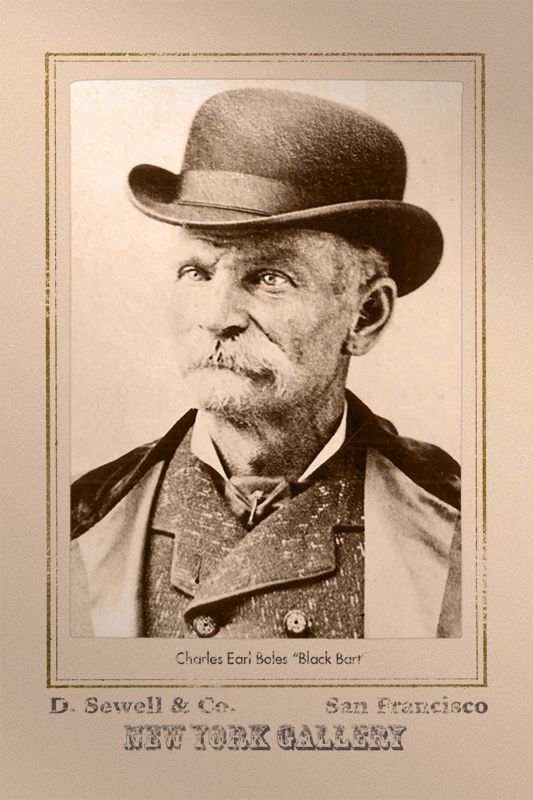The name “Black Bart” is synonymous with outlawry. As a matter of fact, this name has belonged to not one but two notorious outlaws over the years. During the so-called “Golden Age of Piracy,” Bartholomew Roberts was known by the moniker of “Black Bart” and is considered to have been one of the most successful pirates ever to terrorize the trade routes of the Atlantic and Caribbean seas. Over a hundred years after Bartholomew’s time, the notorious stagecoach robber Charles E. Boles adopted the “Black Bart” moniker. It is the Black Bart who terrorized the coaches and wagons of the Wild West, rather than the ships and galleys of the high seas, which we will be discussing in this article. (1)
More California History: The Salton Sea: How a Desert Resort Became an Abandoned Wasteland
Who Was Charles E. Boles?
Charles E. Boles was born in England as the third of ten children. At just two years of age, the young Charles immigrated with his family to Jefferson, New York. Information surrounding Charles’ upbringing is sparse, but it is known that his father owned a farm and that Charles was educated during his childhood. In his early twenties, Charles heard about the 1849 discovery of gold in the hills and mountains of Northern California. With his cousin David as his companion, Boles set out to join the Gold Rush and make his fortune. This would not “pan out” for the boys who would eventually be forced to head East again after failing to strike it rich. In the ensuing years, Charles traveled back and forth from California a bit until his traveling companion passed away and the downtrodden Boles was all but forced to give up on his Wild West ambitions. (2)
In 1854, the defeated Boles settled down in Illinois with his new wife, Mary Elizabeth Johnson, with whom he would father four children. For Charles and Mary, the quiet life would not last. The Civil War began in 1861 and it was not long before Charles volunteered himself as a soldier for the Union. For the next few years, Charles traveled and served and was promoted to First Sergeant. In 1864, Charles E. Boles was shot in the abdomen in Dallas, Georgia. Although his injury was severe, he managed to survive and continued to serve until the 1865 conclusion of the Civil War. (3)

After a life of gold mining and adventure, the Civil War seems to have been a welcome opportunity for Boles to escape the stifling simplicity of his farm in Illinois. With the war behind him and a return to normalcy seemingly inevitable, Boles was restless. Once again called to seek his fortune in the ground, he set out for Montana to mine and prospect for his fortune. Charles began operating his own mine, but his efforts were frustrated by the intervention of some men from Wells, Fargo & Company with whom Boles had some sort of confrontation. In 1871, vowing revenge against the men of Wells Fargo, Charles E. Boles sent his last correspondence to his wife, Mary Elizabeth, before seemingly disappearing. Mary reportedly thought that her husband had died when she stopped hearing back from him. (4)
More Criminal History: The Incredible True Story of the Birdman of Alcatraz
Black Bart: The Bandit Begins
In 1875, the man who was once known as Charles E. Boles resurfaces. Operating under a variety of aliases, Charles E. Boles began robbing stagecoaches throughout Central and Northern California as well as Southern Oregon. His first robbery, which seems to have set the tone for the rest of Boles’ criminal career, was characterized by the unusual politeness with which he conducted himself and by the clever tricks that he employed. During that first robbery, the stagecoach operator noted that Boles never cursed or behaved gruffly. His body and face were disguised beneath sacks of cloth, but his gentlemanly affect stood out to his victim. Boles tricked this first victim by calling out to reinforcements and gesturing towards the bushes where rifle barrels seemed to glint from their hiding places. By the time it was discovered that these “reinforcements” and their “rifles” were only cleverly positioned sticks, Boles was long gone with his prize: roughly 160 dollars. (5)
Over the next eight years, Charles E. Boles, now operating under the “Black Bart” moniker, would commit dozens of stagecoach robberies and cement his reputation as a gentleman bandit. The name “Black Bart” was likely chosen from a popular serialized story which ran in the Sacramento Union. This story also featured a stagecoach robber named Black Bart who was likely named such because of the pirate Bartholomew Roberts. This name choice demonstrates a love of literature for which Boles would eventually be well known. Notably, all of Black Bart’s targets were Wells Fargo coaches. Never did Boles rob the coaches’ passengers either, so his grudge against Wells Fargo is evident throughout his crime spree. (6)
More Fascinating History: Samuel “Black Sam” Bellamy: The Richest Pirate in History
Poet on the Run
Although this only occurred at two of Black Bart’s robberies, perhaps the most famous acts of the bandit are these: his poems. These verses became a strange calling card of Black Bart through which he publicly shared his chosen alias and expressed his frustrations with the Wells Fargo company.
I’ve labored long and hard for bread,
Black Bart, 1877 (7)
For honor, and for riches,
But on my corns too long you’ve tread,
You fine-haired sons of bitches.
Here I lay me down to sleep
Black Bart 1878 (8)
To wait the coming morrow,
Perhaps success, perhaps defeat,
And everlasting sorrow.
Let come what will, I’ll try it on,
My condition can’t be worse;
And if there’s money in that box
‘Tis munny in my purse.
Much much more can be said about the crimes spree of Black Bart, but perhaps the most astonishing and telling feature of his criminal career is the fact that over the course of eight years and 28 robberies, Black Bart is reported not to have ever fired a single shot, such was his cleverness and reluctance to do more harm than necessary. (9)
More Interesting History: The Four Golden Hats: Mysterious Bronze Age Artifacts are More Than They Appear to Be
The Bandit is Caught
In 1883, Black Bart would commit what is believed to have been his final stagecoach robbery. After approaching a coach which had stopped to allow its sole passenger to stretch his legs and engage in some hunting, Boles demanded that the driver throw him the strongbox. Wells Fargo, however, had grown frustrated by the many robberies which had begun to eat into their profits. The strongbox on this particular coach was bolted to the floor to deter robbers who sought to quickly snatch it and be on their way. Not one to give up easily, Black Bart climbed aboard the coach and set to work busting open the box with his axe. Successful, he snatched a bag of gold and some papers before beginning his escape. What he did not count on, though, was that the coach’s passenger had just returned from hunting and was armed. As Charles fled, the passenger managed to shoot him in the hand. Boles made off with the gold but dropped the papers he had stolen as well as a handkerchief. (10)

Wells Fargo’s own detectives had been hunting down Black Bart for quite some time by this point and were eager to follow through on the clues that Boles left behind at this particular scene. Although seemingly insignificant, the handkerchief which Boles had dropped at the scene of the robbery bore the identifying marker of a laundry in San Francisco. This mark would be used to trace the cloth back to the boarding house in which Boles resided. Before long, Charles E. Boles was caught and confessed to the string of robberies committed by Black Bart. (11)
More Bizarre History: An American Mummy: The John Wilkes Booth Conspiracy
Black Bart’s Final Escape
Wells Fargo chose to press charges against Charles E. Boles for just the final 1883 robbery. He was tried and sentenced to spend six years in San Quentin Prison. In just four years, though, Boles was free again having been released for good behavior. In January of 1888, Boles told press upon his release that he was far too old for crime. He returned to San Francisco under the watchful eye of Wells Fargo’s investigators. (12)
Providing one last mystery on which to end the swashbuckling adventures of Black Bart, Charles E. Boles disappeared on February 28th, 1888, just over a month after his release from San Quentin. Wells Fargo’s men lost track of Boles at this time and he has never officially been seen or heard from since. In 1892, Mary Elizabeth Boles listed herself as the widow of Charles Boles in the city directory. It is unknown whether this was done because she knew something that others didn’t or simply because she was ready to move on from the man who had long abandoned her. Over twenty years later, an obituary for an alleged Civil War veteran named Charles E. Boles appeared in a New York newspaper. Nothing further is known about this obituary, but for it to have been “Black Bart,” he would have had to have been 88 years of age at the time of his supposed death. (13)
More Mysterious History: Was the Last Pharaoh of Egypt the Son of Julius Caesar and Cleopatra VII?






